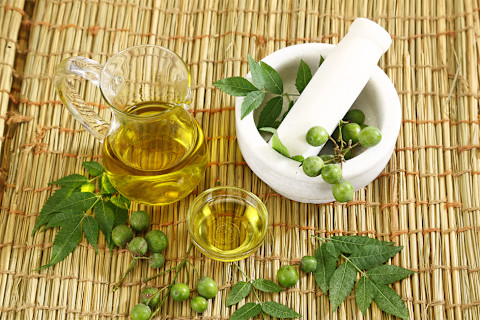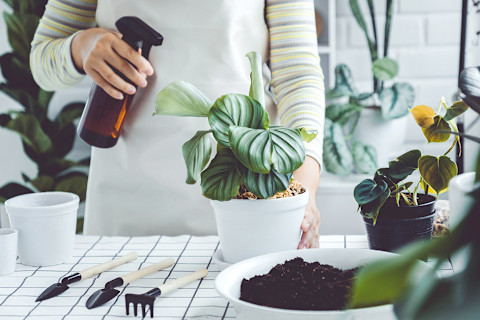You might assume that your indoor houseplants are immune to pest infestations, but bugs can still get to them by way of an open window or a fresh grocery haul. Treating plants with pesticides is one way to protect them from hungry critters, but you'll want to make sure it's a natural option that's safe for home use. That's where neem oil comes in handy.
Here are the whats, wheres, whens, whys, and hows of the plant world's favorite bug spray.
What exactly is neem oil?
Neem oil is a naturally occurring insecticide that comes from the seeds of the neem tree, Azadirachta indica. This quick-growing tree is native to India and Sri Lanka, and it's long been used medicinally in Indian and Ayurvedic medicine.

These days, neem oil is mass-produced for beauty products (it's helpful for calming a number of skin conditions, including psoriasis and eczema) and, the reason we're all here today, plant pest treatments.
The Environmental Protection Agency has approved neem oil as a pesticide, thanks to its waxy consistency that traps bugs and its active ingredient, Azadirachtin. This chemical mimics a bug's natural hormones but disrupts its ability to feed and lay eggs1.
When routinely sprayed on a plant, it will cause any hungry bugs who eat it to "eventually starve as well as have their maturation and reproductive cycles interrupted," Leslie F. Halleck, M.S., a certified professional horticulturist and author, explains. "It can also suppress new eggs from hatching and can potentially disrupt insect developmental and reproductive hormones."
Azadirachtin aside, the nonactive compounds of neem oil—called clarified hydrophobic neem oil—can also be used to essentially smother bugs like fruit flies, fungus gnat larvae, and mealybugs on contact.
So "neem oil" can actually refer to two types of products:
- Ready-to-use sprays: These contain only clarified hydrophobic neem oil and are useful if you have a bug infestation you want to get a handle on quickly. "This type of spray works similar to horticultural oil, which will suffocate an insect on contact. It basically gets into the spiracles of the insect, which is where they breathe," explains the plant care expert behind Plant One on Me Summer Rayne Oakes.
- Concentrates: These contain Azadirachtin. They are often incorporated into long-term pest management plans. Since the Azadirachtin won't kill bugs right away, concentrates are a more preventive measure. When diluted in water, they can be used to keep infestations from spreading by cutting off a pest's reproductive cycle.
What plants to use it on:
Most plant varieties can handle the occasional neem oil spray, but use it sparingly on greenery that has fuzzy leaves (some succulents, cactuses, calathea, etc.). This texture prefers drier conditions, and any excess moisture can throw it off.
Popular plant varieties that you can spray with neem oil include:
Where do you use it on plants?
When spraying a plant with neem oil—either as a bug treatment or preventive measure—it's important to coat both the tops and bottoms of leaves since bugs love to hang out on the underside of foliage. You should also lightly coat the stems and soil, just in case any critters have made their way to those areas.

Only use neem oil on otherwise healthy plants. If your greenery is yellowing, browning, droopy, or otherwise looks off, it might be dealing with water, sunlight, or nutrient imbalance, and the neem oil could make the problem worse.
Finally, don't apply neem oil to plants that are sitting in a bright window. "As with any horticultural oil, it's best not to apply to plants when they are exposed to direct sun rays to avoid leaf scorch," Halleck says.
Before spraying, move your plant into a darker room like the bathroom for application and wait two to three days before putting it back in a sunnier spot. This should leave enough time for the neem oil to break down.
Neem oil can also damage your plants' leaves if used in high quantities, so you always want to follow the instructions on the bottle before spraying.
When do you need to apply it?
If you notice that your houseplants' leaves have tiny holes, webbing, or a sticky substance, it could be a sign of a pest problem. Look closely to see if you notice any little critters on the tops or underbellies of leaves, and treat with neem oil if you find any (more on how to do that below).
Even if your plant is healthy and bug-free, you can apply neem oil every so often as a preventive measure. If you've dealt with bugs in the past or live in a warm, humid climate where insects thrive, you may want to get into the habit.
Neem oil benefits.
It's non-toxic.
Neem oil is great for home use because it's considered a natural and nontoxic pesticide. Though you don't want to take a swig directly from the bottle, it's safe enough to use on plants and herbs that you plan on eating eventually. It also doesn't have the same ecological concerns as chemical pesticides since it doesn't stick around in the environment. Eventually, it gets completely broken down by plants' microbial colonies.
It's pretty safe for other critters.
It's also a pretty targeted solution: Since insects actually need to eat the neem oil to feel its effects, it will only kill pests that pose a genuine threat to your plant. Flies and bees that are just stopping by won't be harmed by it.
How do you apply it?
As a preventive treatment:
- Read the label to see the recommended neem: water ratio. It will likely be around 1 to 2 tablespoons per gallon of water.
- Combine the neem oil and water in a spray bottle and shake well. Adding 1 to 2 tablespoons of Castile soap can help disperse the neem.
- After watering your plant, spray a thin layer all across its leaves (don't forget to get the undersides!), stems, and soil. If you're using it on a plant for the first time, it's not a bad idea to test the spray on a small patch of leaves first and wait a day to see how it reacts.
- Let dry completely in a slightly shaded area. Wait two to three days before placing back in full sun.
- Repeat every two weeks, or as needed.
As a spot treatment for pests:
- Isolate the infected plant from any other houseplants so the critters don't spread.
- Water down the leaves completely (you might need to do this in a bath or shower if it's a larger plant).
- Spray the leaves, stems, and soil with your ready-to-use neem oil spray. (It should have that clarified hydrophobic neem oil to trap bugs instantly.)
- Let sit for two to three days. Keep it away from your other plants and out of the sun.
- Repeat Steps 2 to 4 once or twice more to ensure that it's done its job. Wait two to three days before placing the plant back in your greenery collection.
The takeaway.
If you're taking care of your houseplants with good lighting, proper watering and fertilizing, and well-draining soil, you shouldn't have to worry too much about bugs. But for those times when spider mites or aphids sneak in, neem oil is a good natural pesticide to have on hand.
